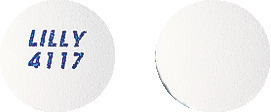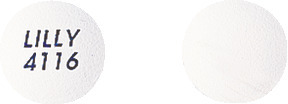What is in this leaflet
This leaflet is designed to provide you with answers to some common questions about this medicine. It does not contain all the available information and does not take the place of talking with your doctor.
The information in this leaflet was last updated on the date shown on the final page. More recent information about this medicine may be available. Make sure you speak to your pharmacist or doctor to obtain the most up to date information on this medicine. You can also download the most up to date leaflet from www.lilly.com.au. The updated leaflet may contain important information about ZYPREXA and its use that you should be aware of.
All medicines have risks and benefits.
Your doctor has more information about this medicine than is contained in this leaflet. Also, your doctor has had the benefit of taking a full and detailed history from you and is in the best position to make an expert judgement to meet your individual needs.
If you have any concerns about taking this medicine, talk to your doctor or pharmacist.
Keep this leaflet with this medicine. You may need to read it again.
What ZYPREXA is used for
ZYPREXA belongs to a group of medicines called antipsychotics. It helps to correct chemical imbalances in the brain, which may cause mental illness.
ZYPREXA is used to treat symptoms of schizophrenia and related psychoses. Schizophrenia is a mental illness with disturbances in thinking, feelings and behaviour.
ZYPREXA alone, or in combination with lithium or valproate, is used for the short-term treatment of acute manic episodes associated with Bipolar I Disorder. ZYPREXA is also a mood stabiliser that prevents further occurrences of the disabling high and low (depressed) extremes of mood associated with Bipolar I Disorder.
Bipolar I Disorder is a mental illness with symptoms such as feeling "high", having excessive amounts of energy, needing much less sleep than usual, talking very quickly with racing ideas and sometimes severe irritability.
Your doctor may have prescribed ZYPREXA for another reason.
Ask your doctor if you have any questions about why ZYPREXA has been prescribed for you.
This medicine is available only with a doctor's prescription.
ZYPREXA is not recommended for use in children under the age of 18 years as there is not enough information on its effects in this age group.
Before taking ZYPREXA
Tell your doctor if you have any of the following conditions or if you have ever experienced any of these conditions.
When you must not take it
Do not take ZYPREXA:
- if you have had an allergic reaction to any type of ZYPREXA or to any of the ingredients listed at the end of this leaflet (see 'Product Description').
Signs of an allergic reaction may include a skin rash, itching, shortness of breath or swelling of the face, lips or tongue. - if the packaging is torn or shows signs of tampering or the tablets or wafers do not look quite right.
- if the expiry date on the pack has passed.
If you take this medicine after the expiry date has passed it may not work as well.
If you are not sure whether you should start taking ZYPREXA, talk to your doctor or pharmacist.
Before you start to take it
Tell your doctor if you have had an allergic reaction to any medicine which you have taken previously to treat your current condition.
Tell your doctor if you have or have had any medical conditions, especially the following:
- tumour of the pituitary gland (a small gland at the base of the brain)
- disease of the blood or bone marrow with a reduced number of white or red blood cells
- disease of the blood vessels of the brain, including stroke
- prostate problems
- kidney or liver disease
- high blood sugar, diabetes or a family history of diabetes
- breast cancer or a family history of breast cancer
- paralytic ileus, a condition where the small bowel does not work properly
- epilepsy (seizures or fits)
- glaucoma, a condition in which there is usually a build up of fluid in the eye
- heart disease, including irregular heart rhythm
- neuroleptic malignant syndrome, a reaction to some medicines with a sudden increase in body temperature, extremely high blood pressure and severe convulsions
- tardive dyskinesia, a reaction to some medicines with uncontrollable twitching or jerking movements of the arms and legs.
- sleep apnoea, a sleep disorder where a person has pauses in breathing or periods of shallow breathing during sleep.
Tell your doctor if you are pregnant or intend to become pregnant. Like most antipsychotic medicines, ZYPREXA is not recommended for use during pregnancy. Newborn babies of mothers taking antipsychotic drugs (including ZYPREXA) during the last trimester of pregnancy are at risk of experiencing extrapyramidal neurological disturbances and/or withdrawal symptoms following delivery. These may include, but are not limited to agitation, tremor, muscle stiffness or weakness, drowsiness, feeding problems, and breathing difficulty. If there is a need to consider ZYPREXA during your pregnancy, your doctor will discuss with you the benefits and risks of using it.
Tell your doctor if you are breast-feeding or plan to breast-feed. It is recommended that you do not breast-feed while taking ZYPREXA.
Tell your doctor if you suffer from lactose intolerance (because ZYPREXA tablets contain lactose).
Tell your doctor if you suffer from phenylketonuria (because ZYPREXA Zydis wafers contain aspartame).
Tell your doctor if you will be in a hot environment or do a lot of vigorous exercise. ZYPREXA may make you sweat less, causing your body to overheat.
Tell your doctor if you smoke. Smoking may affect ZYPREXA or may affect how it works.
If you are elderly with dementia-related psychosis, tell your doctor if you have previously had a stroke or transient ischaemic attack (mini-stroke) or if you have high blood pressure.
Taking other medicines
Tell your doctor if you are taking any other medicines, including any that you buy without a prescription from your pharmacy, supermarket or health food shop.
Some medicines may be affected by ZYPREXA or may affect how it works. These include:
- medicines used to treat a fast or irregular heart beat (arrhythmia)
- medicines taken for anxiety or to help you sleep
- medicines taken for depression
- carbamazepine, a medicine used for mood stabilisation and to treat epilepsy
- other centrally acting medicines (eg. Tranquillisers or strong painkillers)
- ciprofloxacin, a medicine used to treat bacterial infections
- medicines that lower blood pressure
- medicines used for Parkinson's disease
- medicines that can change the heart's electrical activity or make it more likely to change.
Your doctor or pharmacist has more information on medicines to be careful with or avoid while taking ZYPREXA.
Tell your doctor about these things before you take ZYPREXA.
How to take ZYPREXA
Follow all directions given to you by your doctor or pharmacist carefully. These may differ from the information contained in this leaflet.
How much to take
ZYPREXA tablets or wafers:
Your doctor will tell you how many ZYPREXA tablets or wafers you should take. The dose your doctor will prescribe for you will usually be in the range 5 mg to 20 mg per day.
Your doctor may increase or decrease your dose in order to find the appropriate dose for your condition.
A lower starting dose may be prescribed for elderly patients over the age of 65 years.
How to take it
ZYPREXA tablets:
ZYPREXA tablets should be swallowed whole with a glass of water.
ZYPREXA Zydis wafers:
Do not handle the wafers with wet hands as the wafers may break up. ZYPREXA Zydis wafers break easily, so you should handle them carefully.
The wafers can be taken two ways:
- Directly into your mouth
- In a drink
To take a wafer directly into your mouth:
- Hold the blister strip at the edges and separate one blister cell from the rest of the strip by gently tearing along the perforations around it.
- Carefully peel off the coloured backing.
- Gently push the wafer out.
- Put the wafer in your mouth. It will dissolve directly in your mouth, so that it can be easily swallowed.
To take a wafer in a drink: You can also place the wafer in a full glass or cup of water, orange juice, apple juice, milk or coffee, and stir.
Drink it straight away. With some drinks, the mixture may change colour and possibly become cloudy.
Do not place the wafer in cola drinks.
When to take it
ZYPREXA tablets or wafers should be taken once a day as advised by your doctor.
Take your prescribed dose at the same time each day.
ZYPREXA tablets or wafers can be taken with or without food.
How long do I take it
Do not stop taking ZYPREXA just because you feel better. It is important that you do NOT stop taking ZYPREXA unless your doctor tells you.
If you forget to take it
If it is almost time for your next dose skip the dose you missed and take your next dose when you are meant to. Otherwise, take it as soon as you remember then go back to taking your medicine as you would normally.
Do not take a double dose to make up for the dose that you missed.
If you are not sure what to do, ask your doctor or pharmacist.
If you take too much
Immediately telephone your doctor or the Australian Poisons Information Centre (telephone 13 11 26) or the New Zealand National Poisons Centre (0800 POISON or 0800 764 766), or go to Accident and Emergency at your nearest hospital, if you think that you or anyone else has taken too much ZYPREXA. Do this even if there are no signs of discomfort or poisoning.
If you have taken too much ZYPREXA, the most common signs are fast heart beat, agitation/aggression, difficulty speaking, uncontrollable movements and sleepiness (sedation).
While you are taking ZYPREXA
Things you must do
It is important that you remember to take ZYPREXA daily and at the dose prescribed by your doctor.
Tell all doctors, dentists and pharmacists who are treating you that you are taking ZYPREXA.
While you are taking ZYPREXA, tell your doctor or pharmacist before you start any new medicine.
If you become pregnant while taking ZYPREXA, tell your doctor.
Keep all of your doctor's appointments so that your progress can be checked.
- Your doctor should monitor your weight while you are taking ZYPREXA.
- Patients with diabetes or who have a higher chance of developing diabetes should have their blood sugar checked often.
- Your doctor may request you have a blood test from time to time to monitor your cholesterol levels.
- If you are over 65, your doctor may measure your blood pressure from time to time.
Tell your doctor if you are female and your monthly periods are absent for six months or more.
All thoughts of suicide or violence must be taken seriously. Talk to your doctor or mental health professional if you have thoughts or talk about death or suicide; or thoughts or talk about self-harm or doing harm to others. These may be signs of changes or worsening in your mental illness.
Things you must not do
Do not stop taking ZYPREXA, or lower the dosage, even if you are feeling better, without checking with your doctor.
Do not give ZYPREXA to anyone else, even if their symptoms seem similar or they have the same condition as you. Your doctor has prescribed ZYPREXA for you and your condition.
Things to be careful of
Be careful driving or operating machinery until you know how ZYPREXA affects you. ZYPREXA may cause drowsiness in some people.
Be careful when drinking alcohol while taking ZYPREXA. The effects of alcohol could be made worse while taking ZYPREXA.
Your doctor may suggest you avoid alcohol while you are being treated with ZYPREXA.
If ZYPREXA makes you feel light-headed, dizzy or faint, be careful when getting up from a sitting or lying position. Getting up slowly may help.
If outdoors, wear protective clothing and use at least a 30+ sunscreen. ZYPREXA may cause your skin to be much more sensitive to sunlight than it is normally.
Exposure to sunlight may cause a skin rash, itching, redness, or severe sunburn.
If your skin does appear to be burning, tell your doctor.
Make sure you keep cool in hot weather and keep warm in cool weather. ZYPREXA may affect the way your body reacts to temperature changes.
Antipsychotics have the potential to cause cardiac complications and sudden cardiac death.
Side effects
All medicines may have some unwanted side effects. Sometimes they are serious, but most of the time they are not. Your doctor has weighed the risks of using this medicine against the benefits they expect it will have for you.
Like other medicines, ZYPREXA may cause some unwanted side effects. These are likely to vary from patient to patient. Some side effects may be related to the dose of ZYPREXA. Accordingly, it is important that you tell your doctor as soon as possible about any unwanted effects. Your doctor may then decide to adjust the dose of ZYPREXA you are taking.
Tell your doctor if you notice any of the following side effects and they worry you:
- drowsiness
- unusual tiredness or weakness
- fever
- restlessness or difficulty sitting still
- increased appetite, weight gain
- constipation, bloating
- dry mouth
- swelling of your hands, feet and ankles
- aching joints
- nose bleeds
- dizziness, confusion, forgetfulness.
- speech disorder
- sleepwalking
- sleep eating
Some people may feel dizzy in the early stages of treatment, especially when getting up from a lying or sitting position. This side effect usually passes after taking ZYPREXA for a few days.
Tell your doctor if you notice any of the above side effects and they worry you. These are the more common side effects of ZYPREXA.
Tell your doctor as soon as possible if you notice any of the following side effects:
- symptoms of sunburn (such as redness, itching, swelling or blistering of the skin) which occur more quickly than normal
- rash or allergic reaction
- slow heart beat
- changes in sexual functioning or sex drive in men or women
- prolonged and/or painful erection
- unusual secretion of breast milk
- breast enlargement in men or women
- symptoms of high sugar levels in the blood (including passing large amounts of urine, excessive thirst, having a dry mouth and skin and weakness). These may indicate the onset or worsening of diabetes
- reaction following abrupt discontinuation (profuse sweating, nausea or vomiting)
- absence of menstrual periods and changes in the regularity of menstrual periods
- involuntary passing of urine or difficulty in initiating urination
- unusual hair loss or thinning.
These side effects are uncommon but may require medical attention.
Tell your doctor immediately or go to Accident and Emergency at your nearest hospital if you notice any of the following:
- Sudden signs of an allergic reaction such as a skin rash, itching, shortness of breath or swelling of the face, lips or tongue.
- frequent infections such as fever, severe chills, sore throat or mouth ulcers
- bleeding or bruising more easily than normal
- painful swollen leg, chest pain, or shortness of breath as these can be signs of blood clots in the lungs or legs
- seizures, fits or convulsions
- yellowing of the skin and/or eyes
- nausea, vomiting, loss of appetite, generally feeling unwell, fever, itching, yellowing of the skin and/or eyes
- severe upper stomach pain often with nausea and vomiting (inflammation of the pancreas)
- worm-like movements of the tongue, or other uncontrolled movements of the tongue, mouth, cheeks, or jaw which may progress to the arms and legs
- sudden increase in body temperature, sweating, fast heart beat, muscle stiffness, high blood pressure and convulsions
- sharp chest pain, coughing of blood, or sudden shortness of breath
- pain/tenderness in the calf muscle area
- muscle pain, muscle weakness and brown urine
- heart attack
- heart palpitations and dizziness, which may lead to collapse.
- fast breathing, shortness of breath, fever with chills, feeling tired or weak, chest pain while coughing, fast heartbeat. You may have pneumonia.
- fever or swollen glands, especially if they occur together with or shortly after a skin rash
These are very serious side effects. You may need urgent medical attention or hospitalisation.
Most of these side effects are very rare.
The following additional side effects may occur in some groups of people taking ZYPREXA:
Elderly patients with dementia-related psychosis
Elderly patients with dementia-related psychosis may notice the following side effects:
- unusual manner of walking
- falls
- pneumonia
- involuntary passing of urine.
- stroke
- transient ischemic attack – symptoms maybe, but not limited to, paralysis in face, arm or leg.
Parkinson's disease psychosis
Some patients with Parkinson's disease may hallucinate (see, feel or hear things that are not there) or develop worsening symptoms of Parkinson's disease.
Zyprexa in combination with lithium or valproate
Patients with bipolar mania taking ZYPREXA in combination with lithium or valproate may notice the following additional side effects:
- tremors
- speech disorder.
Zyprexa IM injection
Additional side effects seen with ZYPREXA IM Injection are:
- low blood pressure
- slow heart beat
- fast heart beat.
Tell your doctor if you notice anything unusual or if you are concerned about any aspect of your health, even if you think the problems are not connected with this medicine and are not referred to in this leaflet.
Also, some side effects, such as changes to liver function, blood cell counts, cholesterol or triglycerides can occur. These can only be found when your doctor does tests from time to time to check your progress.
Do not be alarmed by this list of side effects. You may not experience any of them.
Other side effects not listed above may also occur in some patients.
Tell your doctor if you notice anything else that is making you feel unwell.
After taking ZYPREXA
Storage
Keep your tablets and wafers in the blister pack until it is time to take them.
Keep your tablets and wafers in a cool, dry place where the temperature stays below 25°C.
ZYPREXA tablets and Zydis wafers should be kept out of direct light.
Do not store ZYPREXA or any other medicine in the bathroom or near a sink.
Do not leave your tablets and wafers in the car on hot days or on window sills. Heat and dampness can destroy some medicines.
All medicines should be kept where young children cannot reach them. A locked cupboard at least one and a half metres above the ground is a good place to store medicines.
There will be an expiry date (month, year) on your ZYPREXA container.
The medicine should not be taken after this date because it may have lost some of its strength.
Disposal
If your doctor tells you to stop taking ZYPREXA or you find that the tablets or wafers have passed their expiry date, please return any left over tablets or wafers to your pharmacist.
Product Description
What it looks like
ZYPREXA tablets are white and are available in the following strengths:
- 2.5 mg tablet
- 5 mg tablet
- 7.5 mg tablet (Australia only)
- 10 mg tablet.
Each ZYPREXA tablet has "Lilly" and an identicode number printed on it. The identicode number for:
- 2.5 mg tablet is 4112
- 5 mg tablet is 4115
- 7.5 mg tablet is 4116
- 10 mg tablet is 4117.
ZYPREXA tablets come in blister packs in the following pack sizes:
- 2.5 mg tablet- 28 tablets
- 5 mg tablet- 7 or 28 tablets
- 7.5 mg tablet- 28 tablets
- 10 mg tablet- 7 or 28 tablets.
ZYPREXA Zydis wafers are yellow and are available in the following strengths:
- 5 mg wafer
- 10 mg wafer
- 15 mg wafer (Australia only)
- 20 mg wafer (Australia only).
ZYPREXA Zydis wafers come in blister packs in the following pack sizes:
- 5 mg wafer - 7 or 28 wafers
- 10 mg wafer - 7 or 28 wafers
- 15 mg wafer - 28 wafers
- 20 mg wafer - 28 wafers
Ingredients
ZYPREXA tablets:
Active Ingredient:
- 2.5 mg tablet - 2.5 mg olanzapine per tablet
- 5 mg tablet - 5 mg olanzapine per tablet
- 7.5 mg tablet - 7.5 mg olanzapine per tablet
- 10 mg tablet - 10 mg olanzapine per tablet.
Inactive Ingredients - lactose monohydrate, hyprolose, crospovidone, microcrystalline cellulose, magnesium stearate, hypromellose and carnauba wax, Colour Mixture White YS-1-18027-A and Edible Blue Ink.
ZYPREXA Zydis wafers:
Active Ingredient:
- 5 mg wafer - 5 mg olanzapine per wafer
- 10 mg wafer - 10 mg olanzapine per wafer
- 15 mg wafer - 15 mg olanzapine per wafer
- 20 mg wafer - 20 mg olanzapine per wafer.
Inactive ingredients - gelatin, mannitol, aspartame, sodium methyl hydroxybenzoate and sodium propyl hydroxybenzoate.
Supplier
ZYPREXA is a product of:
Eli Lilly Australia Pty Ltd
Level 9, 60 Margaret Street, Sydney,
NSW 2000
AUSTRALIA
ZYPREXA is distributed in New Zealand by:
Eli Lilly and Company (NZ) Limited.
PO Box 109 197 Newmarket,
Auckland
NEW ZEALAND
®= Registered Trademark
Australian Registration Numbers
ZYPREXA tablets:
2.5 mg tablet - AUST R 56603
5 mg tablet - AUST R 56604
7.5 mg tablet - AUST R 56605
10 mg tablet - AUST R 56606
ZYPREXA Zydis wafers:
5 mg wafer - AUST R 73388
10 mg wafer - AUST R 73389
15 mg wafer - AUST R 73390
20 mg wafer - AUST R 73391
This leaflet was revised in
November 2023.
vA12
Published by MIMS January 2024









